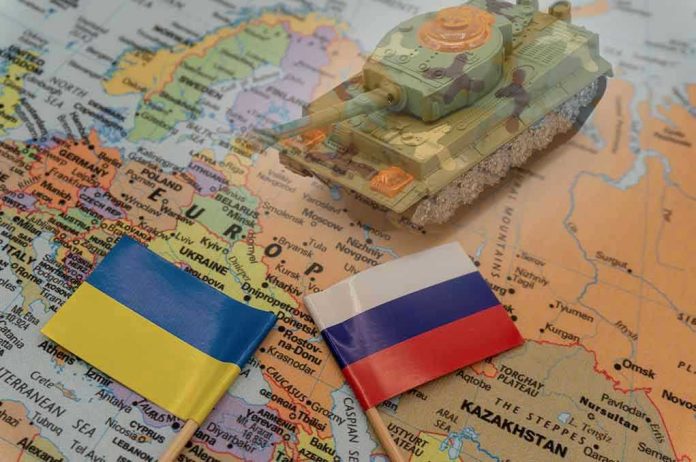
Ahead of a critical Alaska summit, President Trump’s openness to territorial compromises in Ukraine has ignited concerns about sidelining Ukraine’s sovereignty.
Story Highlights
- Trump plans an Aug. 15 meeting with Putin, excluding Ukraine initially.
- Zelenskyy rejects any land-swap proposals, insisting on full sovereignty.
- Russia demands recognition of annexations and neutrality from Ukraine.
- The summit may test confidence-building measures amid ongoing conflict.
Trump’s Alaska Summit with Putin: What’s at Stake?
President Donald Trump is set to meet with Russian President Vladimir Putin on August 15 in Alaska. This meeting is portrayed as a “feel-out” session aimed at exploring potential avenues for a ceasefire in the ongoing conflict between Russia and Ukraine. Notably, Trump’s suggestion that the negotiations might include “some swapping of territories” has been met with sharp opposition from Ukrainian President Volodymyr Zelenskyy. Zelenskyy has declared that any decisions made without Ukraine’s participation are “unworkable,” reaffirming that “Ukrainians will not gift their land.”
The Alaska summit is an exploratory step with the intention of gauging Putin’s willingness to reach a deal. Trump has stated that he will know early in the meeting whether Putin is genuinely interested in negotiations. However, the exclusion of Ukraine from the initial discussions has drawn criticism. Trump has expressed openness to engaging with Zelenskyy and European leaders in subsequent talks, but his comments about territorial negotiations raise concerns about undermining Ukraine’s sovereignty and security.
Russia’s Demands and Ukraine’s Red Lines
Russia’s position remains firm, seeking recognition of its annexations, a neutral Ukraine, and the abandonment of NATO aspirations. These demands are in stark contrast to Ukraine’s insistence on full withdrawal of Russian forces and accountability for war crimes. The disparity in these positions makes any immediate comprehensive deal unlikely. While localized truces and minimal confidence-building steps are being discussed in parallel channels, the fundamental differences in objectives continue to pose a significant challenge.
Analysts suggest that Russia’s ceasefire proposals, which include Ukrainian withdrawals or halts in mobilization and Western aid as conditions for a 30-day truce, are tactical moves designed to secure time and strategic advantage. Meanwhile, Ukraine and its Western allies remain steadfast in their rejection of any proposals that would legitimize Russia’s territorial gains.
The Impact of U.S. Involvement in Mediation
The involvement of the United States in these early talks with Russia, before Ukraine is at the table, has raised concerns about the optics and potential implications. While the meeting in Alaska is positioned as exploratory rather than decisive, the photo-op could be framed domestically in Russia as an international endorsement. This could complicate Kyiv’s position and challenge allied unity.
Experts caution that negotiated ends to wars are rare and fragile. Should a deal emerge, there is an expectation of strong European pushes for a monitored ceasefire and security guarantees. These measures aim to prevent a frozen conflict that could favor renewed Russian offensives, highlighting the delicate balance of diplomacy and strategic interests at play.
Sources:
Peace negotiations in the Russian invasion of Ukraine
Russian Offensive Campaign Assessment, August 11, 2025
Experts React: What’s at Stake in the Trump-Putin Alaska Meeting
Trump-Putin Ukraine Alaska Meeting









